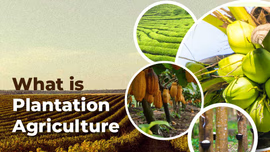What is Compost Pit: Meaning, Process, and Benefits

Table of Contents
- Introduction
- What is Compost Pit?
- How to Make a Compost Pit?
- Advantages of a Compost Pit
- Disadvantages of a Compost Pit
Introduction
A compost pit is among the simplest methods of composting waste as it demands low maintenance. A pit is dug, and organic materials are added to it and covered with soil. Over time, the debris gets decomposed. This simple process is chemical-free and turns waste into nutrient-rich material that can boost plant’s growth.
What is Compost Pit?
A compost pit is a hole in the ground where organic materials such as food leftovers, garden waste and leaves are added. Over time, decomposition of these materials takes place. They break down into compost, which is nutrient-rich organic matter.
The process of composting can take anywhere from a few months to a year, depending on the pile size and materials used. Compost contains several vital nutrients like Potassium, Phosphorus and Nitrogen, which are important for plant growth.
How to Make a Compost Pit?
The process of making a compost pit is as follows:
Collect organic waste
The first step is to gather organic materials such as kitchen scraps, yard trimmings, leaves, grass clippings and plant debris. Do not add meat, dairy products or oily substances, as they can attract pests or slow composting.
Add a variety of materials to the compost pile. Some suitable materials include food scraps, grass clippings and leaves. Wood chips should be added in small amounts, as they take a long time to break down.
Prepare the compost pit
You need a suitable location for the compost pit. Dig a hole in the open space. The depth of the pit can be 30.5 to 38 cm, while its width can be 20 to 25 cm. Effective drainage has to be maintained to prevent waterlogging.
Prepare the material
Cut or break the compost materials that are big in size. A fine compost ensures efficient decomposition. Even though shredding leaves is not mandatory, it can reduce the time taken for them to turn into compost.
Layering the organic materials
A layer of coarse materials, like small twigs or straws, should be placed at the bottom of the pit. It allows better aeration and drainage. You can apply alternate layers of green and brown materials.
Examples of ‘greens’ include grass clippings, food scraps and organic manure, while ‘browns’ include woody materials, straws and leaves. The next step is regularly mixing the pile with a pitchfork or shovel. It improves air circulation, making composting faster and preventing bad smells. After filling the pit, cover it with soil.
Decomposition and maturation
Microorganisms like bacteria and worms break down organic material. After decomposition, the compost changes into a dark and crumbly mixture. This change usually happens over a few weeks or months.
Advantages of a Compost Pit
One of the key advantages of a compost pit is efficient waste management: Rather than throwing away kitchen scraps and yard waste, composting them in a pit lets them break down naturally.
Compost pits can improve the quality of soil as they facilitate better aeration and drainage. It can help prevent soil erosion. Beneficial microorganisms can thrive in the soil, which aids in nutrient cycling. Also, it allows soil to hold water for longer, resulting in improved plant health.
The pit method of composting offers a home to several creatures like earthworms and insects. They can break down organic matter, help it decompose and make the soil healthier.
Disadvantages of a Compost Pit
Although compost pits have several advantages, you must also know their drawbacks. The process of composting waste produces gases like ammonia and hydrogen sulfide, which can develop a foul smell.
Also, their nutrient value has been observed to be lower than that of other types of fertilisers like chemical ones. They might not fulfil the nutrient requirements of plants and crops. Pests such as rodents, flies, and insects can be attracted to compost pits. They look for food scraps and other organic resources in compost for food, resulting in extreme infestations.
If you have a small yard or limited outdoor space, setting up a compost pit might be challenging. You need suitable open space for a compost pit. Also, it demands regular work and care that can be time-consuming.
To sum up, the pit method of composting is an effective medium for turning organic waste into valuable compost. Composting makes soil better, helps reduce waste, and makes the environment healthier. Compost pits are a small but essential step in making the earth more sustainable.
Frequently Asked Questions On What is Compost Pit: Meaning, Process, and Benefits
1. What is compost pit?
A compost pit is basically a hole dug in the ground where the decomposition of raw organic materials takes place.
2. How to make a compost pit?
Dig a 30.5-38 cm deep and 20-25 cm wide hole in your backyard or any other open space. Add compost material at the bottom of the pit and cover it with soil.
3. How is compost pit useful for plants?
Compost pits produce nutrient-rich materials that improve soil fertility and ensure healthy plant growth.
4. How long will a compost pit take?
Based on the pile size and material used, a compost pit can take a few months or years.


Related Blogs












